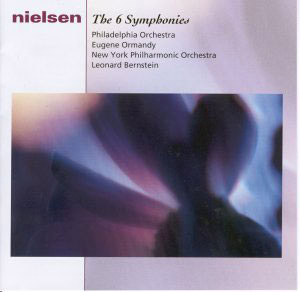Nielsen owes much to the work of Robert Simpson especially
while he was at the BBC. Did Simpson also play a role in bringing about
the playing of the Fifth Symphony at the Edinburgh Festival in 1950?
I still recall the BBC paperback (1965) in which he analysed the music
of Nielsen and Sibelius back to back. 1965 was centenary year for both
composers. Nielsen's more modest revival might also have been partly
as a result of riding on the shoulders of the Sibelius wave that rose
and has continued to rise, crest and break from the mid-1960s onwards.
Interestingly, while Sibelius long outlived his Danish contemporary,
had he died in the same year as Nielsen all the major works would have
been completed; nothing substantial lost.
The warm analogue CBS recording announces itself right
from the first note of the First Symphony. Of course the sprightly
winds and rich strings and brass of the Philadelphians help greatly
in what is, by any account, a grandly committed performance. The same
can be said of the Ormandy Sixth - the most enigmatic of the
set rather like Vaughan Williams' Ninth. Ormandy disentangles the strands
and presents the spare work with the clarity called for in a symphony
that rejoices in chamber textures. The first of the Bernstein readings
follows the First Symphony. The Nielsen Second Symphony is given
with bull-nosed enthusiasm by the NYPO. In comparison with the Ormandy
version of the First Symphony the strings in particular sound a mite
shriller and less amply toned. This is surely a function of both recording
quality and intrinsic sound; that fierceness that Bernstein cozened
from his orchestras. The lift and exultation of the Allegro sanguineo
and the Allegro Colerico both show Bernstein at his short-fused
best. Similar qualities (both positive and negative) run through Bernstein's
New York Inextinguishable. The woodwind 'choir' is however
far more agreeably presented in this symphony than in Number 2. The
Third Symphony is strong and its sound, if a shade acidic, is
ample and full-toned; perhaps a little one-dimensionally forward but
very agreeable. The Third does not suffer from the thinness that afflicts
the Bernstein second. The woodwind are pert and the strings silvery
or of golden weight. On this basis it is a shame that Bernstein chose
to go back to New York to record the other symphonies. You do adjust
to the New York gleam however but it is all rather dazzling in the Second
Symphony. The confident radiance of the finale of the Fourth Symphony
put me in mind of Martinů's
Fourth Symphony - especially its finale. I had not thought about this
until now but what a pity that Bernstein did not feel interested enough
in the Martinů symphonies at least to record the Fourth. I love
the Fifth Symphony. It is the work which, with the Third,
acted as the key to explore everything else. Bernstein is great in this.
From the hushed whisper-chatter of the opening to the carolling French
horns and the side-drum onslaught I rate this a total success. Indeed
the Nielsen 3/5 coupling on a single midprice CD was always one of the
winners in the CBS/Sony catalogue.
Bernstein steers the famous central four symphonies
using the NYPO for 2, 4 and 5 and the Royal Danish for the Espansiva.
These have been available for many years on single mid-price CDs and
five or so years ago all the recordings on this set were issued with
the concertos and various shorter works in a Sony four CD set. Ormandy
and the 'Fabulous Philadelphians' provide the outward-flanking symphonies
- Alpha and Omega.
The notes, in English only, are by Norbert Bolin. My
only real criticism of the notes is that significant Danes such as Louis
Glass, Haakon Børresen and Rued Langgaard are not mentioned at
all. It is a shame that details of the recording dates and locations
are not included.
Given that four Bernstein recordings form the preponderance
of this release I hope that this augurs the appearance of Bernstein's
seven Sibelius symphonies. That set has been in currency on French Sony
for a couple of years now but has not been available through US or UK
outlets. Another augury for the continual low-key spill of Sony releases
may be that the Nielsen wind concertos would make a nice single disc
issue filled out with various recordings of the shorter orchestral works.
This set would not perhaps be a first choice. For that
I would go to the Ole Schmidt set on Regis (similarly at bargain price).
Beyond that I would try for BIS and the Decca San Francisco version
conducted by Herbert Blomstedt. Other alternatives include cycles either
complete or ongoing from ClassicO (Bostock and the RLPO) or Da Capo
(Schønwandt/DNRSO). Nielsen has been fortunate in his discography.
If perhaps you have found other cycles rather bland you should come
to this one (knowing that your investment will be small) for brimming
character. Do not have fears for chromium plated American heartlessness.
Of yield and heart there is no shortage in these readings. These are
superb versions of symphonies 1, 3, 5 and 6 in analogue sound getting
on for forty years old. This is not perhaps a first choice but a radiant
alternative for those open-minded enough and seeking a golden age outside
the Danish vintage. Audio miracles have been wrought to make these recordings
sound as good as they do here. The illustrations of this are in the
grumpy fantasy of the Tema con variazioni of the Sinfonia
Semplice and in the pastoral spells of the Sinfonia Espansiva.
Rob Barnett


